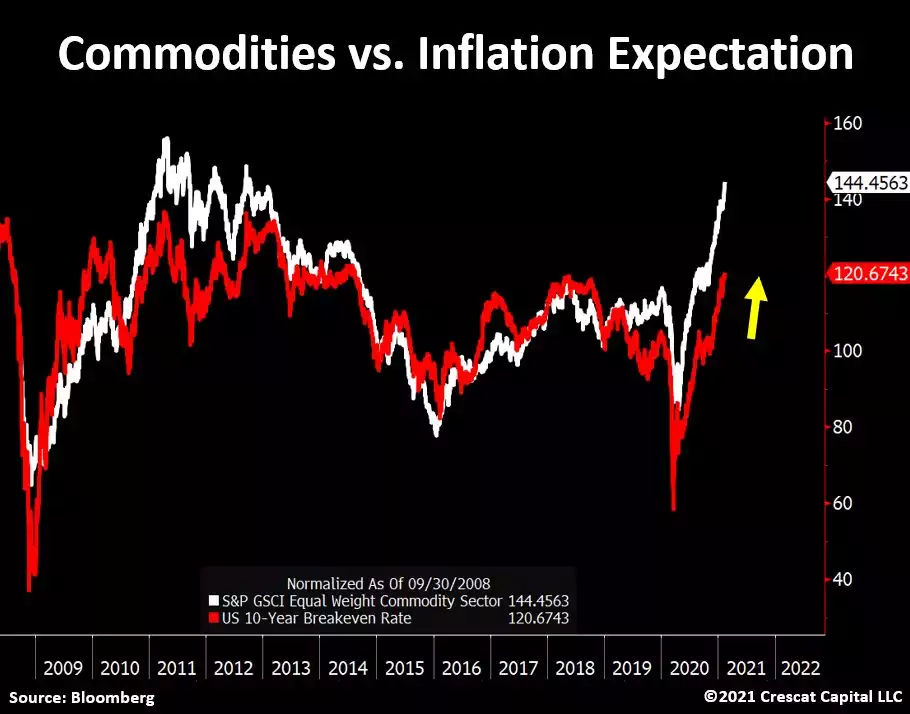MOAR QE
News
|
Posted 18/02/2021
|
8323
In a recent interview with Raoul Pal, Diego Parrilla, portfolio manager at Quadriga Asset Managers and the author of “The Anti-Bubbles,” so beautifully observed we have left the period of ‘risk free interest’ into this current bubble of ‘interest free risk’. But what happens if the interest rate rises? The battle of QE versus rising yield plays on.
Last night was a wooly old night on markets as yet more evidence of rising inflation appeared in data prints in the US at the same time the released Fed minutes made it clear they would consider them “temporary” (until not)… “Participants emphasized that it was important to abstract from temporary factors affecting inflation”… i.e the QE won’t stop. And as for the market bubbles they are inflating “The staff assessed asset valuation pressures as elevated.” And yet the committee deemed “measures of the equity risk premium declined”… the QE won’t stop.
Regardless we saw bond yields rising and getting closer to a market disrupting level which saw shares generally down on the night. Further, given they are rising before ‘official’ inflation is here the negative real interest rates are rising and putting pressure on gold… for now. But whilst gold was down last night, silver rallied strongly again and the GSR dipping below 65. The growing pressures in the silver market (as we discussed yesterday) and its industrial or commodity component enjoying this reflation trade means it could outperform gold for some time yet. Once reflation turns to stagflation, both metals should then rally in unison. But for now, the signs of coming inflation are growing stronger and stronger.

And we reiterate, Australia is as deep into money printing as the US and there is no end in sight. From the AFR’s Chris Joye:
“In contrast to the government’s COVID-19 fiscal policy package, the RBA’s QE via its liquidity operations, and its $180 billion Term Funding Facility, is not a temporary stop-gap.
This makes a third, six-month round of bond purchases, or QE3, a certainty in October, which is likely to be succeeded by QE4 next year and iterations thereafter.
There is no reason to think the RBA will be minded to taper those purchases from $5 billion a week until it has high conviction it will achieve its goals, which will not be until 2022 or 2023.
As governor Phil Lowe’s protégé and putative successor, deputy governor Guy Debelle argued late last year: “In the situation we’re in at the moment, the right decision is to err on too much support rather than too little support.”
MacroBusiness chief strategist David Llewellyn-Smith thinks there is MOAR (that’s more with an exclamation mark…) QE to come:
“Still, the outlook is for MOAR QE not less over time. Why? Three reasons.
For now, Australia is enjoying a terms of trade boom thanks to China’s trade on itself which is flooding fiscal coffers. That will come off hard in 2022 as China reverts to structural reform and any notion of explicit budget repair among fiscal authorities will collapse with it. At that point, letting the budget fix itself via bracket creep will become an interminable drag on the economy, private incomes and households, jeopardising even tax cuts. Even as the Australian dollar falls, the RBA will face a weakening growth and inflation outlook. Upscaled QE will be vital then.
Following that, by late 2023, the housing boom will have run for three years and be demanding macroprudential tightening as financial stability risks rise. The same housing boom is going to expand already bloated private debt to above 200% of GDP so consumption will also decline.
Again, still MOAR QE will be required as that risk is sat upon in 2024. Ramped-up TFF may also be needed depending upon how successful is macroprudential tightening.
And that’s before I even reference three other key inputs. If virus disruptions become a part of normal life, which seems likely, then that’s MOAR QE. If not, then the Canberra immigration consensus will throw open the borders and wages be crushed all over again also equalling MOAR QE. Then there is the structural China decoupling, another demand headwind, especially as universities are dragged in. MOAR QE.
Any way you cut it, RBA QE is here to stay and will grow.”
That, as is the case for central banks all around the world, means more debasement of currencies, more fuel for an out of control inflation outlook and more reason to hold hard assets such as gold, silver and Bitcoin. The latter just hit another all time high last night, over USD52,000 as it surges onwards in this environment.